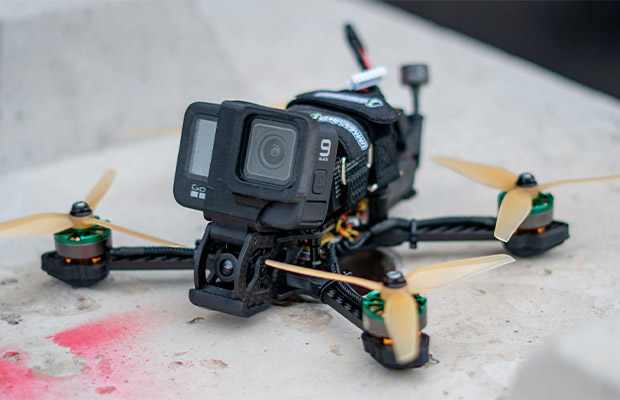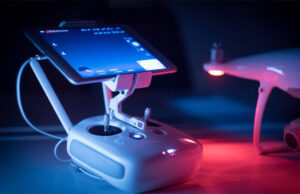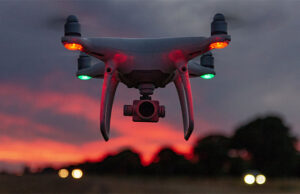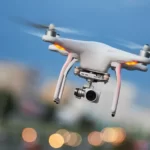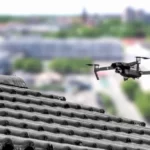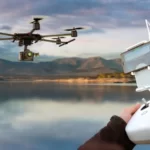Looking for the best FPV drone? This guide will assist you in making a decision, warn you about potential pitfalls, and provide you with current prices.
First-person view (FPV) drones provide an exhilarating flying experience for pilots, and the best FPV drones on the market offer a variety of options for both novices and experts. By wearing goggles with a heads-up display, it allowed you to fly as though you were seated in the pilot’s seat.
On the market, there are lots of FPV drones. For your reference, we’ve chosen the top 12 options; keep reading!
Table of Contents
Best FPV Drones in 2023: Top Picks
- 1. DJI FPV Combo: Best FPV drone for cinematography
- 2. iFlight Nazgul 5: Best FPV drone for freestyle (and GoPros)
- 3. DJI Avata: Bringing FPV to everyone
- 4. BetaFPV Cetus FPV: A complete kit
- 5. EMAX TinyHawk 3 RTF: Best tiny drone for FPV beginners
- 6. iFlight ProTek25 Pusher CineWhoop FPV: Best 2.5in frame for cinematographers
- 7. Makerfire Micro FPV: Best budget option for kids and beginners
- 8. Emax Hawk Pro 5: An ideal option to explore the possibilities of the hobby
- 9. GEPRC CineLog 35: Powerful compact enthusiast FPV quad
- 10. Walkera F210: A (literally) solid option for experiencing FPV
- 11. DJI Mini SE: A consumer drone with a hint of FPV
- 12. Eachine Novice-IV 4in Long Range FPV Racing Drone Kit: Best FPV racing drone
Best FPV Drones Reviews
1. DJI FPV Combo: Best FPV Drone for Cinematography
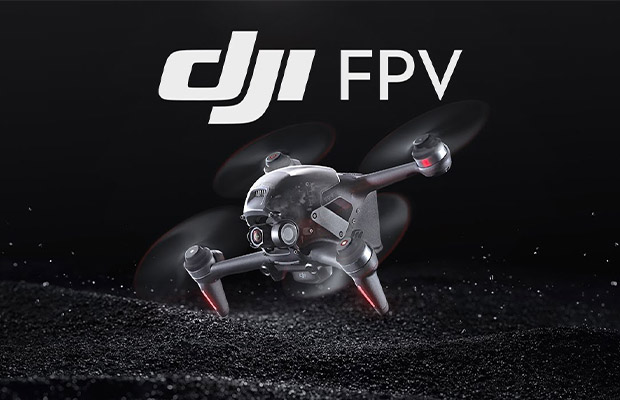
Reasons to Buy
- Amazing acceleratio
- Effective safety sensor
- Some replaceable part
- Partial motorized gimbal on FPV
Reasons to Avoid
- In Acro mode it needs a lot of space
- Expensive path into FPV
- Parts are difficult to replace and expensive
The DJI FPV is a versatile drone with a good camera that can record 4K footage at 60 frames per second if you have access to quick MicroSD cards(opens in new tab). Even though it only has mechanical stabilization on the X axis, the camera is unusually equipped for a dedicated FPV drone because good digital image stabilization effectively manages camera vibration on the Y axis. The frame has some roll-bar-like protection for the camera despite the delicate gimbal motors’ apparent vulnerability. Perhaps more importantly, collision sensors, DJI’s other key area of development, are crucial in this situation.
The DJI FPV can be flown at two slower (yet still thrilling) speeds than most FPV drones and has very good collision sensors in place. Instead of colliding with objects, they will either come to a stop, hover, or even steer around them. The drone has the typical GPS-powered return-to-home feature expected on a consumer drone, as well as an “all stop” button that can start hovering almost instantly. The visual quality is breathtaking when compared to early analog equivalents, and DJI’s dedicated 120fps goggles are also thoughtfully constructed, with a large field of view that is not too taxing on the eyes or headband.
2. IFlight Nazgul 5: Best FPV Drone for Freestyle (and GoPros)
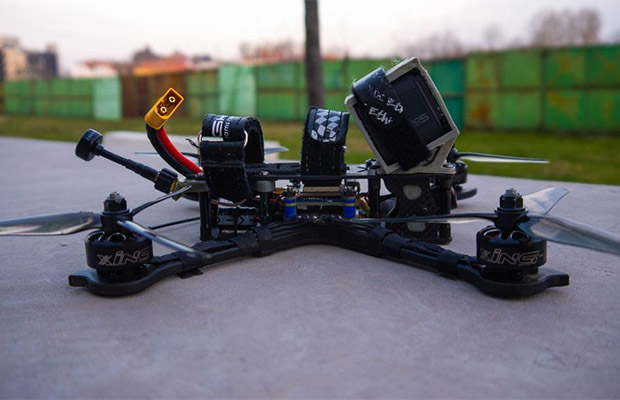
Reasons to Buy
- Thick carbon fiber arms with corner protection
- GoPro mount
- Excitingly fast
Reasons to Avoid
- Through-X prop configuration
- You’ll need to budget for HD video
Powered by Xing-E 2207 2750KV motors, the Nazgul 5 might be named after the baddies in Lord of the Rings, but that power is a useful thing if you choose to act responsibly; many drone pilots will lament the increase in weight to the latest GoPro Hero 9 Black(opens in new tab), but this powerful device doesn’t seem to mind the extra weight. (Maybe this is the reason why it employs the Succex-EF4 flight stack.)
This drone’s 5mm thick carbon arms make it difficult to break even in a collision that happens fairly quickly, but if you want to try, iFlight is selling the device in both (quick) 4S and (screeching) 6S versions. Even a fixed wing cannot outrun it. Even pilots used to the user-friendly camera drone experiences should be able to transition to the world of FPV because the company is well known for the quality of its default PIDs (flight settings), and this device is no exception.
You’ll probably need DJI FPV Goggles, which are a bit of an investment in and of themselves but come with the Caddx vista HD digital video transmission system built into the drone. Aside from that, you receive a nice assortment of extras in the box, including props, tools, rubber battery stickers, antennas, and more.
3. DJI Avata: Bringing FPV to Everyone
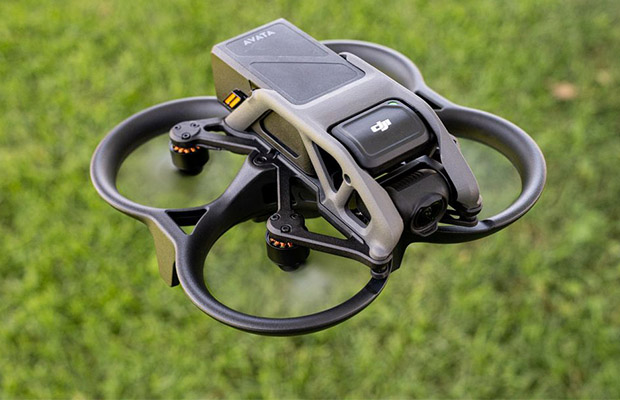
Reasons to Buy
- Robust protective frame design
- Produces gorgeously steady swooping video
- Manual camera options
- Easy to control even for first-time pilots
- Better battery life than typical FPV drone
Reasons to Avoid
- No forward collision sensors
- DJI Motion Controller can’t achieve maximum speed
- DJI Goggles 2 can mist up on warm days (despite fan)
- Video can drop out at under 400m
- No bag in the Fly More kit
The strong are simple to love (we verified!) FPV flight is now more accessible thanks to the DJI Avata. If this is your first FPV aircraft, you will need to make a sizeable investment because you will need all the extras and space to fly. But what’s fascinating is how simple things are after that, with consumer safety features, stability, and a great camera.
Getting out the soldering iron and putting together a kit of parts is no longer necessary if you want to fly in first person view and capture breathtaking footage. The Avata’s camera stabilization system, in our opinion, appears to produce much smoother 4K footage than the conventional GoPro mounted on a self-build; after all, it is connected in a way that a separate camera is not.
The ports have inconveniences as flaws. The Fly More kit is a cumbersome collection of accessories to carry, so we would have liked to see one of DJI’s custom bags included.
4. BetaFPV Cetus FPV: a Complete Kit
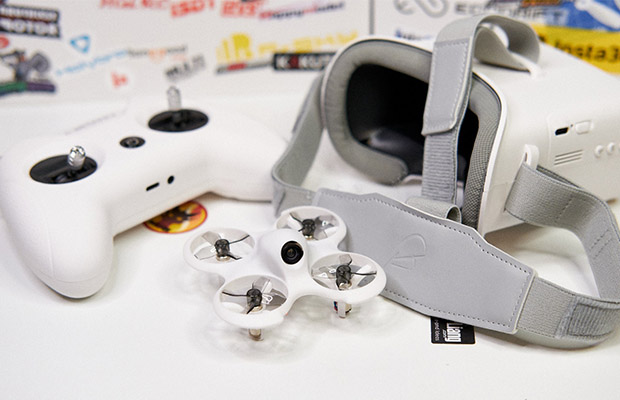
Reasons to Buy
- Altitude hold function
- Complete “Ready to Fly” kit
- Learn freestyle or hover
Reasons to Avoid
- Won’t carry a camera
A relatively uncommon addition to the Cetus is an optical flow sensor, a little drone. This provides both a gentle automatic landing when the battery is running low as well as a drift-free hover, both of which are enormous benefits for new pilots. The three modes, which include a full traditional FPV style, allow beginning pilots to progress. The technology is the same; you can use the same goggles and controller with other real RF drones.
Since the controller has real RC-controller sticks surrounded by a housing more akin to a game, it actually has a particularly pleasing feel for “noobs.” When connected to drone simulators, it can indeed be used as a USB joystick. The fact that this is only a live-view experience—you’ll need to buy more expensive goggles if you want to record—is unfortunate, but the emphasis of this package is on entertainment.
5. EMAX TinyHawk 3 RTF: Best Tiny Drone for FPV Beginners
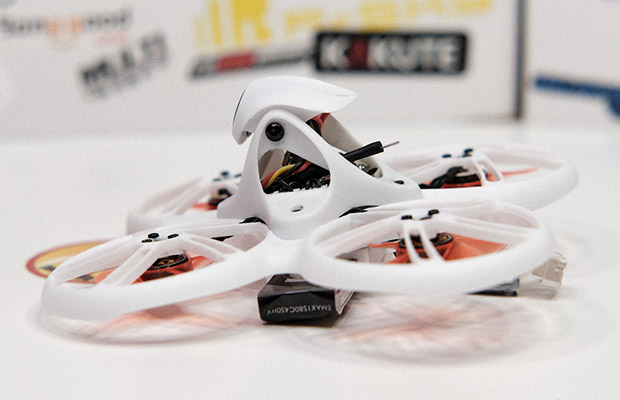
Reasons to Buy
- Flexibile: only needs a USB charger
- Auto White Balance
- Rates easy for beginners
- Good choice for STEM
Reasons to Avoid
- Frame can be scuffed by concrete crash
- Different PID profiles for 1S or 2S batteries
to and and
It can travel at speeds of up to 50 mph (again, impressive for a vehicle this size) or stay in the air for up to 7 minutes. As their brightness responds to the accelerator, the array of LEDs gives you the chance to impress the assembled crowds if you’re doing it in low light.
Previously, Emax’s kits came with controllers that resembled gamepads; however, the new E8 transmitter has a more traditional feel and is better for learning pinch controls. Additionally, it has a mount for the Transporter 2 receiver screen that is included. This screen can be mounted on the controller or worn like a traditional FPV screen. Additionally, the Transporter 2 can record video to an SD card.
The camera produces surprisingly good-looking video, much better than other small drones, thanks to its dynamic range, white balance, and the 200mw VTX (transmitter), which ensures better transmission than many in the category. However, it lacks the power to carry a GoPro. The only real complaint is the ‘land now’ warning seems to come a little early, so the drone is better suited to racing flight than aggressive “acro” (acrobatics).
6. IFlight ProTek25 Pusher CineWhoop FPV: Best 2.5in Frame for Cinematographers
Reasons to Buy
- Low vibration frame (better footage)
- Beginner-friendly packaging
- Powerful enough to lift GoPro 9 or 10
Reasons to Avoid
- Bring your own goggles
- No pairing instructions or video
Like it or not, the historical chain of names ending in “—whoop” is now part of quadcopter lore, and this is a Although it has the strength to lift a GoPro, the Cinewhoop isn’t too dangerous to avoid up close. (Opens in new tab) The inverted engine configuration, which gives the product a somewhat skeletal hovercraft-like appearance but creates a cleaner airflow beneath it for smoother flight (and, by extension, smoother video), is what the word “pusher” in the product name refers to.
Since it is so small, it can be flown through tight spaces while pursuing objects like skateboarders. It weighs a few more grams than other 2.5-inch drones. Although any GoPro with image stabilization will see no problems in any case, we did wonder if switching the bull-nosed props out for 5-blade types might offer a smoother flight.
Flexibility is a key benefit of FPV, and while the ProTek25 is also available in analog, the digital option includes the Caddax Polar Vista 60fps FPV camera, which will connect to the DJI goggles and controller.
7. Makerfire Micro FPV: Best Budget Option for Kids and Beginners
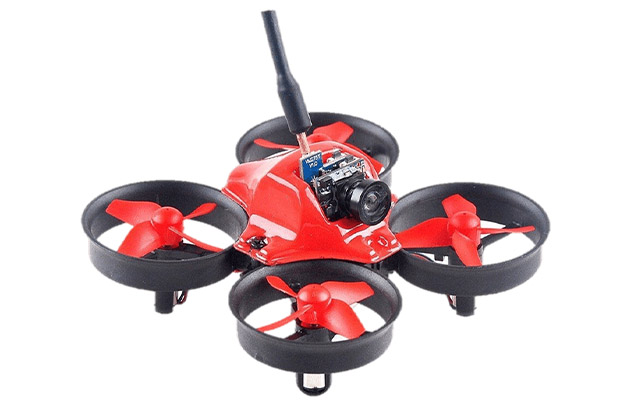
Reasons to Buy
- Altitude hold
- One key return
- Headless mode
- 40 channels
Reasons to Avoid
- Camera angle fixed
Your humble writer was transported in a bus to the desert outside of Las Vegas sometime before the virus spread, but he wasn’t there to be killed by the mob; instead, he went to see what these tiny drones were up to. Even though I’ve long suspected that I was only brought back to the Consumer Electronics Show because I didn’t crash my micro-copter too badly (not for lack of trying), it’s good to see that the toothy micro-copter has now arrived in shops.
The price of the kit, which comes with goggles and a controller, is what really makes this helicopter stand out from the crowd. Although the construction quality may not be as good as some machines’, the goggles still have useful features, including standby charging and enough vents to prevent problems. The camera’s 170-degree field of view is useful for flying while wearing goggles as well. The system has all the same safety features, in addition to rolls and flips, associated with toys in that category too, making for an easy transition. This is very helpful for both first-timers and for those making the transition from gadget store toys.
8. Emax Hawk Pro 5: An Ideal Option to Explore the Possibilities of the Hobby
Reasons to Buy
- Fully customizable
- 32-bit speed controller
- Alternate props to emphasis speed or flight time
Reasons to Avoid
- Must supply your own goggles, transmitter, receiver, battery
This is one geeky quad (we’re really sorry if you haven’t realized by now that the FPV community is very self-centered if you haven’t made it this far through the list). The BUZZ Freestyle is made to move quickly, but it also has a built-in camera that, if you supply your own FPV goggles, you can use to fly through. Like most drones in this class, you can adjust the camera’s angle from the ground up, but there is no way to change it while the drone is in flight. The Caddx Ratel 1200TVL HDR camera, while still using NTSC or PAL, does provide a better-than-average video signal, which is a plus.
When it comes to the more advanced aspects of the hobby, EMAX does offer a helping hand by offering two full sets of propellers, one of which they refer to as “AVAN Flow” for speed and the other as “AVAN Scimitar” because it offers a longer flight time. In addition to the enormous 3K of carbon fiber woven into the frame, we appreciated the rubber pads on the base that protected the screws from a hard landing.
You’ll be ready to go once you have a FrSky receiver, batteries, and a balance charger.
9. GEPRC CineLog 35: Powerful Compact Enthusiast FPV Quad
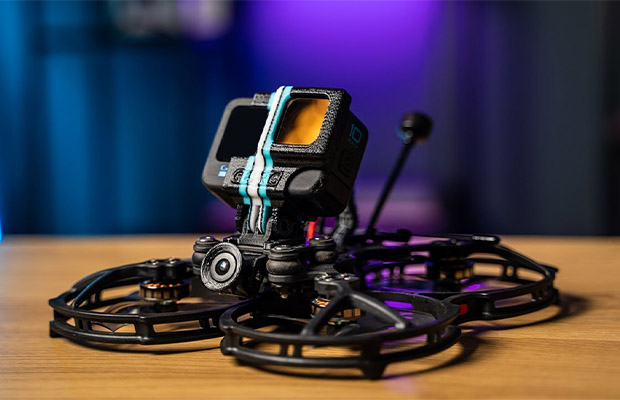
Reasons to Buy
- Protective edge
- Supports HD Digital VTX
Reasons to Avoid
- Drone only
The CineLog 35 is larger than some whoop-class drones and has some improvements that allow for longer flights. Alternatively, you could give up a few minutes and use your strength to lift heavier GoPro cameras. With the help of the included mount, you can hold a GoPro 10 aloft to capture your flights on film for posterity. Even better, the camera will be connected to a platform that will dampen the jelly effect from the drone’s motors if it is attached. However, the aircraft’s 203 x 203mm pusher frame weighs 236.6g, so you can fly without worrying about weight restrictions if you’re not using a recording camera. GEPRC provides the compact quad in both a 4S and 6S version.
10. Walkera F210: a (literally) Solid Option for Experiencing FPV
Reasons to Buy
- Everything except batteries and a charger
- An ideal first-time FPV quad if you’re moving into the hobby
Reasons to Avoid
- Must supply your batteries & charger
- This is a hobbyist machine; be prepared to crash and repair
The quad comes with everything you need to start flying, with the exception of a 14.8 4S battery and the balance charger you’ll need to recharge it. This deal isn’t the cheapest on this site. However, the majority of developing hobbyists want to make that decision for themselves, so there is really no loss there. The F210 is primarily made of carbon fiber, so it will survive a few bumps, which is just as well. The transmitter is powered by AA batteries, which should last a while.
We weren’t entirely certain about the two-blade props that were included; three-blade props can occasionally produce more power, but the difference wasn’t always very noticeable. Why not tri-blade props? Walkera once offered them in a 3D automatic flight mode (the drone would fly them backwards automatically when the drone was inverted), but that novelty doesn’t appear to be on the list anymore, and we can’t say we miss it. Well, at least it comes with goggles and a controller, which makes it a great FPV quad for beginners.
11. DJI Mini SE: a Consumer Drone With a Hint of FPV
Reasons to Buy
- Quality video and photos
- Can be used as an ‘ordinary’ drone
- Record video and images onboard
Reasons to Avoid
- Video a little laggy
- Relatively slow
- FPV to goggles requires extra devices
The DJI Mini SE captures excellent video and images for a drone that is significantly less expensive than others in its stable, so there is no disputing its quality or relative value. The only issue is that, strictly speaking, it isn’t technically an FPV drone, according to the definitions used by enthusiasts.
That said, the view seen on your phone screen (acting as a monitor) is a first-person view. After all, Doom is a shooting game and doesn’t require VR headsets. It is also possible to view that phone image in front of your eyes in first-person view (FPV) if you use a headset that can accept an HDMI signal or a mirroring video signal from your phone. If the latter, use a gadget like a MiraScreen to connect the HDMI to your phone.
Given the digital video, especially mirror-cast (control isn’t as responsive as on a racer), it’s probably helpful that the Mini SE isn’t the fastest drone. However, the experience is still positive and includes all the benefits of DJI’s video recording system. Setting the Gimbal Mode to FPV in the Control menu will cause the camera to tilt with the drone (instead of maintaining level horizons), making it appear to be a “real” FPV drone.
12. Eachine Novice-IV 4in Long Range FPV Racing Drone Kit: Best FPV Racing Drone
Reasons to Buy
- Impressive kit overall
- Beeper for finding crashed drones
- GPS return to home feature
Reasons to Avoid
- More expensive than many other analogue
- RTF kits Beginners may find it too powerful
The Eachine Novice-IV Kit, despite being a beginner kit with everything you need to get started and three flight modes to accommodate different skill levels, could be classified as an intermediate RTF kit due to its impressive features and functionality. There is a beeper for locating the drone in case it crashes out of view, and the Novice-IV has a built-in GPS that will direct it to land if communication with the controller is lost.
Since the controller is a multi-protocol Radiomaster TX12, it can be utilized with a variety of FPV drones. It’s a low-cost Radiomaster model, but it’s still a great choice for the kit and one that could be useful for many years.
What is An FPV Drone?
The most immersive and interactive flying experience is provided by an FPV drone.
You will be looking through the drone’s eyes rather than from the outside.
This is made possible by the camera’s ability to transmit live video, which you can view on a monitor (a high-end screen or even just your smartphone), video goggles, or a monitor for a more immersive experience.
You can be sure that this kind of drone will enhance all of your drone-related activities, including photography, site-exploration, impromptu acrobatics, and of course drone racing.
In general, there isn’t much of a difference between conventional drones and FPV ones; they have similar designs and perform the same functions. Your FPV drone can be flown similarly to a regular drone, and FPV versions of common drones are frequently available.
However, FPV drones can occasionally require do-it-yourself installation and are more prone to mishaps (hence, FPV simulators for pilots to practice). The flying experience is where there is unquestionably the biggest difference: First Person View drones give you a realistic sense of speed, maneuvers, etc.
Read More: What is an FPV Drone?
Different FPV Drone Types
Below are the most common types of FPV drones.
Ready-to-fly
RTF drones are exactly what their name implies—they are shipped prepared to fly. This indicates that these models come equipped with everything you require to begin flying.
They consist of the actual drone itself, an RC transmitter (the controller), a receiver, a battery, and occasionally even a cheap battery charger.
Some kits also include extras like higher-quality battery chargers, FPV equipment, and money kits.
As they typically don’t require any additional purchases of parts or DIY assembly, ready-to-fly drones are ideal for beginners.
Bind-and-fly
Similar to the previous model, bind-and-fly models are pre-built and come with everything you need except a transmitter.
The good news is that these drones already come with a receiver, so you can connect any transmitter of your choice.
Additionally, you may occasionally need batteries to finish these drones.
Kits
The majority of drone hobbyists want to build their own drones. Purchasing FPV kits is the best option for you if you are familiar with a drone’s parts and want to customize your vehicle.
There are many different kits available, ranging from inexpensive to expensive, complex to simple to assemble. Your budget, DIY skills, and the end product all play a role in this.
one of those operators you can create on your own? Learn how to construct your very own FPV drone.
DIY Racing Drones
One of the most thrilling aspects of being a drone racer is getting to customize your car. Racing drones, unlike regular DIY drones, are designed with a specific goal in mind, so you’ll want to enhance qualities like flight speed, agility around obstacles, wide signal range, and extended flight time.
Our Verdict
The DJI FPV Combo is a good option if you’re looking for the best FPV drone for freestyle. You can purchase Makerfire Micro FPV if you want a cheap one. Please comment below with your pick-up.
You May Also Like: Best Drone For Real Estate
FAQs
Is FPV Drone Illegal?
Technically, you can fly FPV drones without a ham radio license in some cases – however, if you exceed power limits or use incorrect frequency bands without a license, you could be in violation of For this reason, before using any FPV drones, we advise that you pass your ham radio license exam.
Read More: Is It Illegal To Fly A Drone Over Private Property?
Can I Fly FPV Without a Spotter?
All FPV flights require a visual observer (spotter) to be present for the duration of any flight.
What is the Highest Flying Military Drone?
The MQ-9 Reaper is a high-altitude UAV with a service ceiling of 15,420 meters (50,000 feet).
